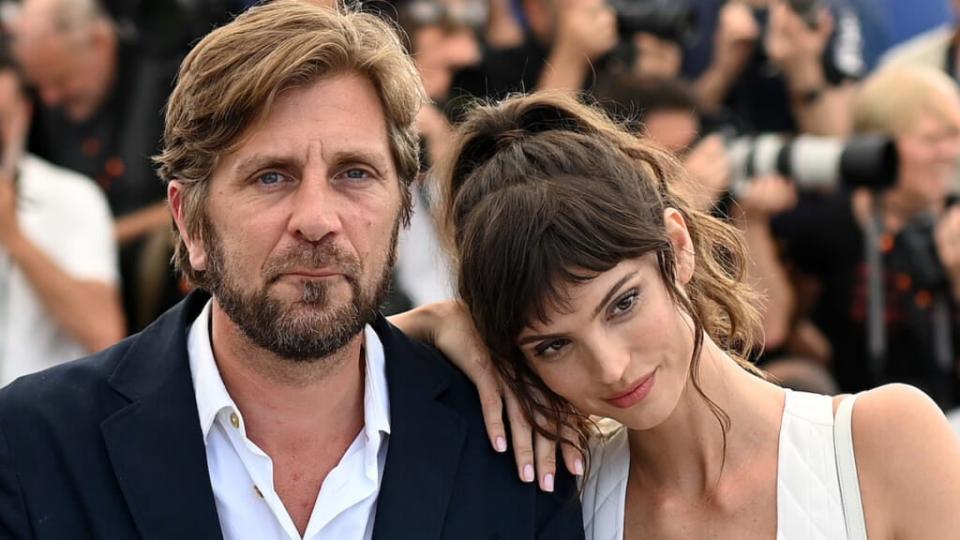Why ‘Triangle of Sadness’ Director Decided to End the Film With a ‘Strong Human Dilemma’
- Oops!Something went wrong.Please try again later.
A version of this story about “Triangle of Sadness” first appeared in the Guild & Critics Awards/Documentaries issue of TheWrap’s awards magazine.
(This article contains spoilers for “Triangle of Sadness.”)
For director Ruben Östlund, an integral part of his job as a filmmaker is viewing his movie with audiences and then answering questions from the crowd afterward. This ethos has been especially true and fruitful in regards to Östlund latest “Triangle of Sadness,” which opened in theaters in October and is now available to rent on streaming services. The film ends with a tremendous moment of decision, and Östlund is only too happy to talk all about it.
“Triangle of Sadness” won Östlund his second Palme d’Or at the Cannes Film Festival last spring – a very rare honor for such a wild, raucous comedy. While introducing the film at a recent screening in New York, the Swedish director reached into his jacket pocket and took out his phone. “We didn’t make the movie for this little individual screen,” he said to the audience, gesturing at his device. He pointed his thumb at the gigantic movie screen behind his shoulder: “We made it for this.”
Like fellow theater-experience-purists such as Christopher Nolan, Denis Villeneuve and Steven Spielberg, Östlund sees irreplaceable value in a large crowd gathering to watch a movie together. Unlike those other three, his preferred genre is comedy. And though he has built a fan base with his ski slope farce “Force Majeure” and his art world satire “The Square,” the new movie is his wackiest, wildest roller coaster ride yet.
“We could feel, especially after these couple of years with the pandemic, that the industry was struggling to convince people to leave their screens at home,” Östlund explained to TheWrap. “And I’ve thought a lot about how we can reenergize cinema culture. Because the connection with the audience is super, super important. It is the most important thing for us.”
Focusing on the experience of two fashion models Carl (Harris Dickinson) and Yaya (Charlbi Dean) aboard a doomed luxury yacht captained by a drunk Marxist (Woody Harrelson), the film follows its characters along a windy and unpredictable path, including a visceral, hysterical 18-minute depiction of seasickness on the boat, complete with cascades of vomit and bathroom sewage.
But the final third of the movie is set on a desert island, where a few survivors of a pirate attack aboard the yacht have been forced to survive together. Among the group are the two fashion models and a middle-aged Philippine maid named Abigail (Dolly De Leon, in a revelatory performance), whose job on the yacht was to clean toilets. On the island, she is the only member of the group who knows how to fish or start a fire. Hence, she sits atop the social hierarchy and everyone else needs to obey her command if they want to eat. The servant is the master now.
Also Read:
Why a Catchy Dance Song About Pandemic Lockdowns Appears in ‘Triangle of Sadness’
“The character of Abigail was so important for me,” said Östlund. “We are living in a world where people are abusing power, but the ones who are being abused, they – we – also inherit that behavior. The abuse of power is going to create abuse of power. Of course, Abigail has learned this dynamic by being in the world before. So when they get to the island and her currency is more valuable, she wants to take advantage of that. I knew I wanted her to be the master of the game.”
In an uncanny reverse of gender roles, Abigail takes the young, handsome Carl as her personal concubine. In the final scene of the film, Abigail and Yaya decide to take a hike together to the other side of the island. When they get over a craggy mountain range, the two women discover an elevator leading up to a luxury hotel. They pause and sit together before moving on.
In developing the narrative and figuring out how he wanted to end the story, Östlund sought inspiration from an 1882 play by Henrik Ibsen called “An Enemy of the People.”
“There’s a great theatre director in Germany called Thomas Ostermeier and I went to see his version of this Ibsen play,” Östlund said. “He ended that play with a strong human dilemma. Essentially, a journalist has to decide if he reveal the truth about poisoned water in a village, which if he does, will put his father-in-law’s spa out of business. And the play ends with the characters looking at papers but we don’t know what’s on it. I thought it was genius to end the play in a strong dilemma where you can actually think, “OK, how would I handle this?'”
Also Read:
Cannes 2022 Winners: ‘Triangle of Sadness’ Wins Palme d’Or
At the end of “Triangle of Sadness,” Abigail picks up a large stone, raises it up in her arms, and walks towards Yaya from behind, clearly intending to eliminate her with a smash to the back of her head. Östlund ends on Abigail’s face, mixed in a swirl of emotions, as the woman is deciding to drop the stone or commit murder with it.
“In that scene, Abigal and Yaya see their rescue and they really hug each other genuinely and sit there together,” Östlund said. “Because they also like each other. And Abigail goes and picks up this stone and she’s walking towards the back of a human being and she has this stone in her hand. And either she will drop the stone to the ground, and lose her position on the island, or she will hit Yaya in the head and maybe maintain her position.”
He added, “It was so important for me to create the situation where the audience could identify with Abigail (murdering Yaya). And with the possibility of violence. I’ve been asking the audience when we have Q&As after the screenings now, ‘How many of you think Abigail kills Yaya?’ Many think that she does.”
We asked Östlund what he thinks. He smiled. “People ask me what happens in the last scene,” he said, “but I have not decided. I really don’t know. In fact, I’m not so interested in the answer in my own mind. It is the possibility of her doing it – and how we can all relate to that – which is what I’m interested in.”
De Leon, however, does have an opinion, which she shared at Cannes. “Of course Abigail kills (Yaya,) of course,” she said in May.
But “Triangle of Sadness” does not fully conclude with the dilemma of whether Abigail slays Yaya. Östlund also includes a short shot of Carl running at breakneck speed through the jungle, trying to reach the two women, as the fantastic dance hit “We’ve Lost Dancing” blasts on the soundtrack.
Östlund said, “For that shot, I told Harris (Dickinson), ‘You have been on the beach camp with the others and the beach vendor has arrived there. And maybe the beach vendor has told you that on the other side of the island, in the direction that Yaya and Abigail have gone, there is a resort hotel there.’ And Carl realizes that for Yaya and Abigail, the whole situation maybe will be dangerous. He feels like something bad could happen, so that is why he’s running like that, bloody and frantic.”
However the director is open to alternative theories for that concluding shot too. “An audience member told me ‘No, Carl is running so hard to get his male identity back. He’s struggling with the gender expectations and the last shot is a metaphor for his lost male identity, which has been totally lost.’ And I love that interpretation too.”
Östlund, who smiles and laughs frequently during our interview, turns somber when he talks South African model-turned-actress Dean, in the leading role of Yaya in the film, who died in August from a sudden illness at the age of 32. “It was a shock and it is a tragedy,” he said. “Mainly for her family and her fiancé and her brother and her best friends. But also because Charlbi was genuinely such a caring person. At the screenings I’ve been to, we always dedicate the film to her. We can only imagine where she would have gone with her talent and her career.”

As for the filmmaker’s future, he has already sketched out the story for his next movie, which might prove even more comic and turbulent than “Triangle of Sadness.” He is more than eager to share details – in fact, during the promotional campaign for “The Square” in 2017, he peppered journalists with details from his in-the-works screenplay for “Triangle of Sadness,” including the aforementioned ending.
His upcoming film, which he’s still writing, is set inside a passenger plane during a long flight, and it is called “The Entertainment System is Down,” a hilariously self-explanatory title. “On the plane, the people whose TV screens aren’t working are offered a cheese sandwich and mineral water as compensation,” he said. “That’s when the real trouble starts for the crew.”
We didn’t ask Östlund to spoil the ending, though the mischievous director smiled gleefully as he said, “It is a disaster film.”
Read more from the Guild & Critics Awards/Documentaries issue here.


